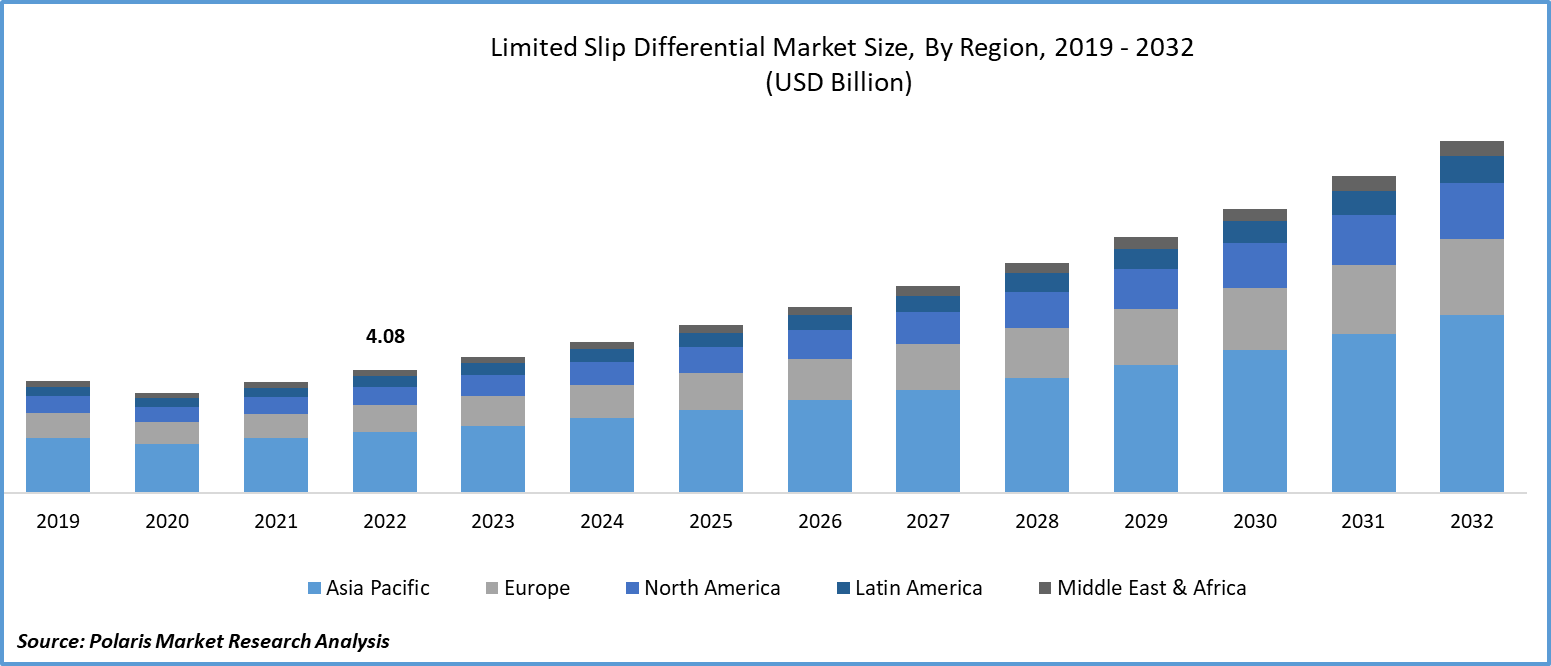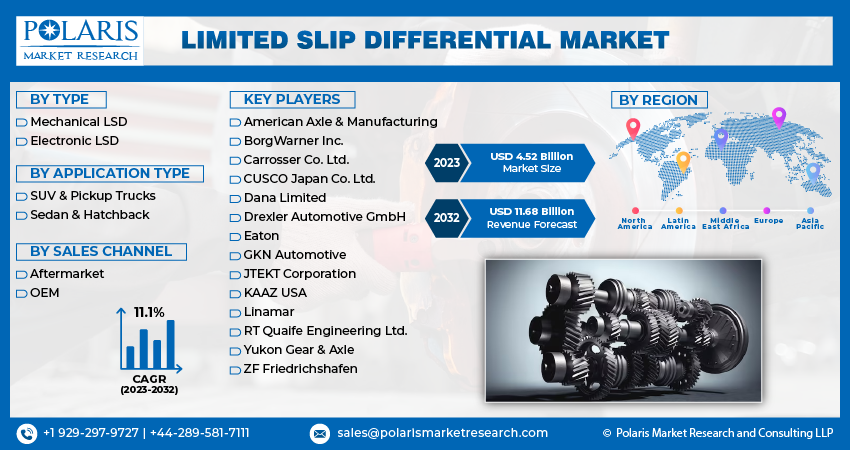
Limited Slip Differential Market Share, Size, Trends, Industry Analysis Report, By Type (Mechanical LSD, Electronic LSD); By Application Type; By Sales Channel; By Region; Segment Forecast, 2023 – 2032
- Published Date:Dec-2023
- Pages: 117
- Format: pdf
- Report ID: PM4123
- Base Year: 2022
- Historical Data: 2019-2021
Report Outlook
The global limited slip differential market was valued at USD 4.08 billion in 2022 and is expected to grow at a CAGR of 11.1% during the forecast period.
The rapidly surging prevalence of all-wheel drive and four-wheel drive vehicles and the continuous increase in the demand for commercial vehicles, coupled with the incorporation of technological advancements in powertrains, drivetrains, and vehicle stability, among others, are among the primary factors fostering the growth of the global market. Additionally, the rising investments in R&D activities in order to develop new technologies & innovations in the automotive industry, like electronic slip differentials & active LPDs, are further likely to contribute significantly towards the market growth.

To Understand More About this Research: Request a Free Sample Report
- For instance, in January 2022, Toyota Kirloskar Motor announced the launch of its new lifestyle utility vehicle named “The Hilux” in India, which comes with a wide range of features, including world-class engineering, enhanced safety, and automatically limited-slip differential, among others.
Moreover, some of the LSD systems providers are now focusing on the integration of active torque vectoring capabilities, which goes beyond traditional LSD functions by actively applying varying amounts of torque to each wheel individually while enhancing the overall cornering performance and stability, which in turn, creating lucrative growth opportunities for the market.

For Specific Research Requirements: Request for Customized Report
The outbreak of the COVID-19 pandemic has significantly impacted the growth of the limited-slip differential market. The rapid spread of the deadly coronavirus across the globe has forced countries to take stringent actions like lockdowns, social distancing measures, and trade restrictions, due to which many automotive manufacturers across the world faced huge disruptions in their operations as a result of factory closures, labor shortage, and transportation restrictions.
Industry Dynamics
Growth Drivers
- Increased adoption and higher preferences for luxury SUVs are driving market growth.
The Limited Slip Differential (LSD) market is experiencing substantial growth, propelled by a notable surge in the global preference for SUVs and premium vehicles. This shift is attributed to the rise in consumer disposable income and a heightened attraction towards premium automobiles that boast luxury features, providing enhanced convenience for customers. The market is witnessing a significant boost due to these leading factors.
For instance, a report by the International Energy Agency (IEA) highlights an increase in the global fleet of SUVs. From less than 50 million in 2010, the fleet expanded to approximately 320 million in 2021. In 2021 alone, the worldwide SUV fleet witnessed a surge of over 35 million units, and this figure is expected to continue rising in the years ahead. This trend underscores the escalating adoption and strong preferences for luxury SUVs, contributing significantly to the growth trajectory of the Limited Slip Differential Market.
Report Segmentation
The market is primarily segmented based on type, application type, sales channel, and region.
|
By Type |
By Application Type |
By Sales Channel |
By Region |
|
|
|
|
To Understand the Scope of this Report: Speak to Analyst
By Type Analysis
- The electronic LSD segment is expected to witness the highest growth.
The electronic LSD segment is expected to witness the highest growth rate over the next coming years on account of its superior performance compared to the mechanical LSDs and its ability to provide improved stability and traction, mainly during cornering and slippery road conditions. In addition, several leading product manufacturers globally are investing heavily in the research & development of electronic LSD to meet the emerging consumer demand and expand their product offerings, which, in turn, have a positive impact on the segment market growth.
The mechanical LSD segment held a significant market share in terms of both revenue and volume in 2022, which is mainly driven by their widespread use in a range of applications, especially in luxury and high-performance vehicles along with the surging utilization of mechanical LSDs in motorsport and racing applications for optimizing the acceleration out of corners even at high speeds.
By Application Type Analysis
- SUV & pickup trucks segment accounted for the largest market share in 2022
The SUV & pickup trucks segment accounted for a noteworthy market share. The growth of the segment market can be largely accelerated by the rising adoption of SUVs and pickup trucks across both developed and developing economies, as these differentials help them to easily identify the changing road conditions and also improve the overall control over the vehicle.
With the significant increase in the use of SUVs and pickup trucks in various forms of motorsports, such as off-road racing and truck racing, LSDs are essential to be used in these scenarios to optimize traction and control during challenging driving conditions, thereby propelling the demand and need for LSDs in the segment market.
By Sales Channel Analysis
- OEM segment led the industry market in 2022
The OEM segment led the market with a considerable share in 2022, which is significantly driven by the continuously surging focus of OEMs to incorporate LSDs into their vehicles mainly for the enhancement of performance, as they can help distribute power in a more effective way to the wheels and also minimize wheel spin and maximizes grip. Apart from this, as emissions and fuel efficiency standards are becoming more stringent all over the world, automotive manufacturers are implementing the utilization of drivetrain components to achieve better efficiency, which, in turn, has propelled the demand for limited slip differentials at a rapid pace.
Regional Insights
- Asia Pacific region dominated the global market in 2022
The Asia Pacific region dominated the global market with a substantial share in 2022 and is likely to continue its market dominance throughout the study period, mainly attributable to increasing consumer preferences for high-performance vehicles and SUVs as a result of rising consumer disposable income in countries like China and India and the surge in automobile production across the region leading to higher demand for advanced or innovated limited slip differentials. For instance, according to a report by Trading Economics, the disposable personal income in India has increased to INR 272,995,370 Mn in 2022 from INR 238,573,760 Mn in 2021 and is expected to reach INR 314,795,178 Mn by 2025.
North America will grow at a rapid pace, owing to rising penetration for the adoption of all-wheel drive system-equipped vehicles and growing regulations about driving safety introduced by governments in countries like the US and Canada.
Key Market Players & Competitive Insights
The limited slip differential market is highly fragmented due to the robust presence of large manufacturers globally and increasing investments and focus by these manufacturers on the development of innovative electronic limited slip differentials in order to upgrade their product offerings and cater to the emerging product demand. Several manufacturers are also focusing on the adoption of cost-reduction strategies along with acquisitions and partnerships to innovate modern differential technologies.
Some of the major players operating in the global market include:
- American Axle & Manufacturing
- BorgWarner Inc.
- Carrosser Co. Ltd.
- CUSCO Japan Co. Ltd.
- Dana Limited
- Drexler Automotive GmbH
- Eaton
- GKN Automotive
- JTEKT Corporation
- KAAZ USA
- Linamar
- RT Quaife Engineering Ltd.
- Yukon Gear & Axle
- ZF Friedrichshafen
Recent Developments
- In January 2022, OHV introduced slip differential for 2WD & 4WD Mercedes-Benz Sprinter-based vans. The new differentials are mainly designed for the uplifting and building of community and also for the fleet services with a goal to improve the off-road and inclement weather ability.
- In August 2021, Eaton Vehicle introduced new specialized differentials that are specially designed for electrified vehicles with comparable performance to ICE vehicles. The new range of differentials is engineered, tested, & validated
Limited Slip Differential Market Report Scope
|
Report Attributes |
Details |
|
Market size value in 2023 |
USD 4.52 billion |
|
Revenue Forecast in 2032 |
USD 11.68 billion |
|
CAGR |
11.1% from 2023 – 2032 |
|
Base year |
2022 |
|
Historical data |
2019 – 2021 |
|
Forecast period |
2023 – 2032 |
|
Quantitative units |
Revenue in USD billion and CAGR from 2023 to 2032 |
|
Segments Covered |
By Type, By Application Type, By Sales Channel, By Region |
|
Regional scope |
North America, Europe, Asia Pacific, Latin America; Middle East & Africa |
|
Customization |
Report customization as per your requirements with respect to countries, regions, and segmentation. |
FAQ's
The global limited slip differential market size is expected to reach USD 11.68 billion by 2032
Key players in the market are Dana Limited, KTEKT Corporation, Eaton, American Axle & Manufacturing, GKN Automotive
Asia Pacific contribute notably towards the global limited slip differential market
The global limited slip differential market is expected to grow at a CAGR of 11.1% during the forecast period.
The limited slip differential market report covering key segments are type, application type, sales channel, and region.
